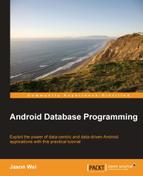Book Description
Applying database concepts to mobile applications is straightforward with this practical tutorial aimed at Google’s Android platform. It will walk you through local and external data storage methods, using clear instructions and practical examples.
- Master the skills to build data-centric Android applications
- Go beyond just code by challenging yourself to think about practical use-cases with SQLite and others
- Focus on flushing out high level design concepts, before drilling down into different code examples
In Detail
We live in an increasingly data-centric and data-driven world. On top of that we live in a very mobile-centric world with the rise of Android smart phones and tablet devices and the surge in demand for the Android platform. Along with the demand for more data, there is a demand for efficient, "snappy" applications, and so developers need to have a strong understanding of when different data storage methods are appropriate and when they are not.
Mastering how to use these two fields to successfully create a powerful application will help you boost your knowledge and skills in this area.
"Android Database Programming" is designed to help developers create and design data-centric mobile applications on Google’s Android platform. As the world goes increasingly mobile and as consumers’ demand for data-centric applications rises, knowing how to combine the two effectively will become an increasingly important asset to have as a developer. The book starts by looking at the various local data storage methods on Android, and finishes off by examining external databases and ways you can utilize them from within an Android application.
This book starts by looking at local data storage methods, focusing on writing SQLite databases for your application and also looking at ways to bind these databases to the user interface. The book, through its practical approach, strives to teach you by examples. Each chapter focuses on flushing out high level design concepts, before drilling down into different code examples.
As you continue you will look at external databases, primarily Google’s App Engine platform, and pull things together by helping you understand how you can request, cache, and display this data. The book then teaches the ways and techniques to utilize such external databases from within your application.
Table of Contents
- Android Database Programming
- Table of Contents
- Android Database Programming
- Credits
- About the Author
- About the Reviewers
- www.PacktPub.com
- Preface
- 1. Storing Data on Android
- 2. Using a SQLite Database
- 3. SQLite Queries
- 4. Using Content Providers
- 5. Querying the Contacts Table
- 6. Binding to the UI
- 7. Android Databases in Practice
- 8. Exploring External Databases
- 9. Collecting and Storing Data
- 10. Bringing it Together
- Index
